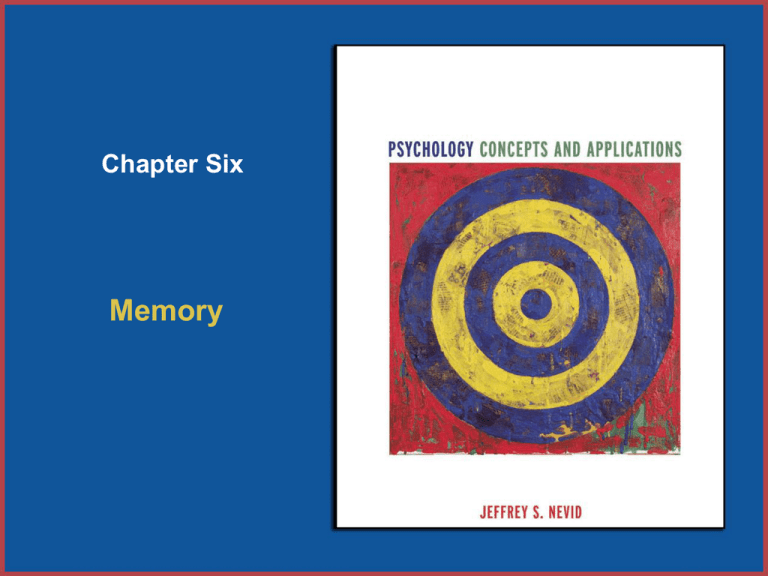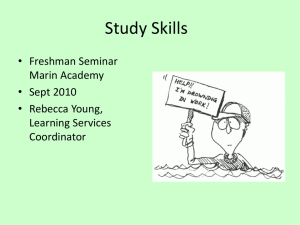
Chapter Six
Memory
Copyright © Houghton Mifflin Company. All rights reserved.
6–1
Did You Know That…
• A man was able to memorize lists of
hundreds of meaningless syllables and recite
them fifteen years later?
• Some research subjects did better on a
memory test when they were submerged in
water?
Copyright © Houghton Mifflin Company. All rights reserved.
6–2
Did You Know That… (cont.)
• Though most people can retain only about
seven items in memory at any one time, you
may be able to juggle sixteen, twenty, or more
items in your mind by using a simple memory
device?
• A good way to retain information you’ve just
learned is to sleep on it?
• The World Wide Web was modeled on the
way the human brain works?
Copyright © Houghton Mifflin Company. All rights reserved.
6–3
Did You Know That… (cont.)
• People can be misled into believing they saw
a yield sign at an accident scene when they
actually saw a stop sign?
• Fewer than half of the people tested in a
research study could pick out the correct
drawing of a penny?
• If your hippocampus were removed, each
new experience would come and go without
any permanent trace left in your brain that the
event ever happened?
Copyright © Houghton Mifflin Company. All rights reserved.
6–4
Module 6.1
Remembering
Copyright © Houghton Mifflin Company. All rights reserved.
6–5
Module 6.1 Preview Questions
• What are the basic processes and stages of
memory?
• What is the constructionist theory of memory?
• What are flashbulb memories?
• What factors influence the accuracy of
eyewitness testimony?
• Are recovered memories of childhood sexual
abuse credible?
Copyright © Houghton Mifflin Company. All rights reserved.
6–6
What Is Memory?
• The system that allows us to retain
information and bring it to mind.
Copyright © Houghton Mifflin Company. All rights reserved.
6–7
Figure 6.1:
Three Basic Processes of Memory
Copyright © Houghton Mifflin Company. All rights reserved.
6–8
Memory Encoding
• The conversion of information into a form we
can store in memory.
• Types of encoding
– Acoustic: Code by sound
– Visual: Code by forming a mental picture
– Semantic: Code by meaning
Copyright © Houghton Mifflin Company. All rights reserved.
6–9
Memory Storage and Retrieval
• Memory Storage: The process of retaining
information in memory.
• Memory Retrieval: The process of accessing
and bring into consciousness information
stored in memory.
– Some memories retrieved effortlessly.
– Retrieval cues often required to bring memories to
awareness.
Copyright © Houghton Mifflin Company. All rights reserved.
6–10
Retrieval Cues
• Encoding Specificity Principle: Retrieval will
be more successful when cues during recall
are similar to those present at the time of
encoding.
• Context-Dependent Memory Effect: Setting
context of learning serves as set of retrieval
cues.
• State-Dependent Memory Effect: Better recall
when in same physiological or psychological
state while learning/recalling.
Copyright © Houghton Mifflin Company. All rights reserved.
6–11
Figure 6.2:
ContextDependent
Memory
Effect
Copyright © Houghton Mifflin Company. All rights reserved.
6–12
Three-Stage Model of Memory
• Sensory memory
• Short-term memory
• Long-term memory
Copyright © Houghton Mifflin Company. All rights reserved.
6–13
Sensory Memory
• Storage system that holds sensory
information for a very short time.
– Held in the “sensory register”
• Iconic Memory: Sensory register for visual
stimuli.
– George Sperling’s ( 1960) research
– Eidetic imagery or photographic memory
• Echoic Memory: Sensory register for auditory
stimuli.
Copyright © Houghton Mifflin Company. All rights reserved.
6–14
Short-Term Memory (STM)
• Sensory memories are transferred into shortterm or working memory.
• STM retains and processes information for up
to 30 seconds.
• Relies mostly on acoustic coding.
• Holds information long enough for it to be
actively worked on or processed by the brain.
Copyright © Houghton Mifflin Company. All rights reserved.
6–15
How Much Information Can STM Hold?
Remember these numbers: • 18294624
– Now recall the numbers
• 6293
• 9284619384
– Now recall the numbers
– Now recall the numbers
• 73932
• 1992199319941995
– Now recall the numbers
– Now recall the numbers
• 835404
– Now recall the numbers
• 3820961
– Why were these numbers
easier to remember?
– Now recall the numbers
Copyright © Houghton Mifflin Company. All rights reserved.
6–16
Storage Capacity of STM
• Storage capacity is about 7 items, plus or
minus 2.
– George Miller’s “Magic 7”
• Enhanced by:
– Chunking
– Maintenance rehearsal
Copyright © Houghton Mifflin Company. All rights reserved.
6–17
Figure 6.3: Three-Component Model
of Working Memory
Copyright © Houghton Mifflin Company. All rights reserved.
6–18
Long-Term Memory (LTM)
• Retains information beyond short term
memory.
• Consolidation: The process of converting
short-term memories into long-term
memories.
– First 24 hours is critical.
– Dreams occurring during REM sleep may play an
important role.
Copyright © Houghton Mifflin Company. All rights reserved.
6–19
Transferring Information to LTM
• Depends on semantic coding or coding by
meaning.
• Elaborative Rehearsal: Focus on the meaning
of material while rehearsing.
– Associate new material with familiar, meaningful
information.
• How is information in LTM organized?
Copyright © Houghton Mifflin Company. All rights reserved.
6–20
Figure 6.4: Semantic Network
Source: Collins,
A.M., & Quillan, M.
R. (1969). Retrieval
times from
semantic memory.
Journal of Verbal
Learning and
Verbal Behavior, 8,
240-247.
Copyright © Houghton Mifflin Company. All rights reserved.
6–21
Long-Term Memory:
Levels-of-Processing
• How information is processed at determines
how well or how long information is stored in
memory.
• Deep processing (meaning) – Best retention
• Shallow processing (superficial) – Poor
retention
Copyright © Houghton Mifflin Company. All rights reserved.
6–22
Figure 6.5:
Three-Stage Model of Memory
Copyright © Houghton Mifflin Company. All rights reserved.
6–23
Figure 6.6:
Types of Long-Term Memory
Copyright © Houghton Mifflin Company. All rights reserved.
6–24
Figure 6.7: Declarative Memory
Copyright © Houghton Mifflin Company. All rights reserved.
6–25
Copyright © Houghton Mifflin Company. All rights reserved.
6–26
Reliability of Long-Term Memory
• Can we trust our memories?
• Constructionist Theory: Memory is a
reconstructive process.
– Memories may be distorted.
– Better recall for information consistent with
existing memory schema.
• Flashbulb Memories: Vivid, lasting, and highly
detailed memories.
– But still prone to distortions
Copyright © Houghton Mifflin Company. All rights reserved.
6–27
Eyewitness Testimony
• Can be flawed and mistaken.
– Misinformation effect
• Accuracy influenced by:
–
–
–
–
–
Ease of recall
Degree of confidence
Knowledge of a subject
Racial identification
Types of questions
Copyright © Houghton Mifflin Company. All rights reserved.
6–28
Figure 6.9: Misinformation Effect
Copyright © Houghton Mifflin Company. All rights reserved.
6–29
Recovery of Repressed Memories
• Controversial issue
• Total lack of memory is rare, but possible
such memories may be lost.
• False memories have been induced in
experimental studies.
• But, are recovered memories genuine?
Copyright © Houghton Mifflin Company. All rights reserved.
6–30
Module 6.2
Forgetting
Copyright © Houghton Mifflin Company. All rights reserved.
6–31
Module 6.2 Preview Questions
• What are the major theories of forgetting?
• How is recall related to the methods used to
measure it?
• What is amnesia, and what causes it?
Copyright © Houghton Mifflin Company. All rights reserved.
6–32
Decay (or Trace) Theory
• Memories gradually
fade and deteriorate
over time.
• Ebbinghaus’s (1885)
early experimental
studies
Copyright © Houghton Mifflin Company. All rights reserved.
6–33
Figure 6.10:
Ebbinghaus Forgetting Curve
Copyright © Houghton Mifflin Company. All rights reserved.
6–34
Decay Theory (cont.)
• Savings Method: Compare number of trials
need to learn material with number of trials
needed to relearn the material at a later time.
• Massed vs. Spaced Practice Effect
– Massed practice (or cramming) causes mental
fatigue that interferes with learning and retention.
• Weakness of theory: Fails to account for
unevenness of memory decay over time.
Copyright © Houghton Mifflin Company. All rights reserved.
6–35
Figure 6.11:
Retroactive and Proactive Interference
Copyright © Houghton Mifflin Company. All rights reserved.
6–36
Minimizing Interference
• Sleep on it
• Rehearse fresh memories
– Overlearning
• Take breaks
• Avoid sequential study of similar material
Copyright © Houghton Mifflin Company. All rights reserved.
6–37
Serial Position Effect
• The tendency to recall items at the start of
end of a list better than items in the middle of
the list.
– Interference is likely explanation for effect.
• Primacy Effect: Tendency to recall items
better when they are learned first.
• Recency Effect: Tendency to recall items
better when they are learned last.
Copyright © Houghton Mifflin Company. All rights reserved.
6–38
Figure 6.12: What Image Appears
on the Front of a Penny?
ANSWER:
Drawing
(h)
Copyright © Houghton Mifflin Company. All rights reserved.
6–39
Retrieval Theory
• Forgetting is the result of failure to access
stored memory.
• Encoding failure
• Lack of retrieval cues
– Tip-of-the-tongue phenomenon
Copyright © Houghton Mifflin Company. All rights reserved.
6–40
Motivated Forgetting
• Sigmund Freud
• Repression: Threatening memories kept
hidden from awareness.
– Traumatic experiences, unacceptable impulses,
desires
• Problems with Freud’s concept of repression
– Doesn’t account for ordinary forgetting.
– Traumatized people often retain vivid if somewhat
fragmented memories of experience.
Copyright © Houghton Mifflin Company. All rights reserved.
6–41
Measuring Memory
• Recall tasks
– Free recall
– Serial recall
– Paired-associates recall
• Recognition tasks
Copyright © Houghton Mifflin Company. All rights reserved.
6–42
Amnesia
• Loss of memory
• Types
– Retrograde amnesia
– Anterograde amnesia
– Childhood amnesia
• Causes
– Physical damage or disease
– Psychological: dissociative amnesia
Copyright © Houghton Mifflin Company. All rights reserved.
6–43
Module 6.3
The Biology of Memory
Copyright © Houghton Mifflin Company. All rights reserved.
6–44
Module 6.3 Preview Questions
• Where are memories stored in the brain?
• What is LTP, and what role do scientists belief
that it plays in memory function?
• What is the role of the hippocampus in
memory?
• What have scientists learned about the
genetic basis of memory?
Copyright © Houghton Mifflin Company. All rights reserved.
6–45
Where Do Memories
Reside in the Brain?
• Karl Lashley’s (1890-1958) search for the
engram
– Term used to describe a physical trace or etching
of a memory in the brain.
• Lashley concluded memories scattered
throughout the brain.
Copyright © Houghton Mifflin Company. All rights reserved.
6–46
Circuitry of Memory
• PET scans and fMRI research
• Neuronal Networks: Memory circuits in the
brain that consist of complicated networks of
nerve cells.
Copyright © Houghton Mifflin Company. All rights reserved.
6–47
Figure 6.13:
Brain
Structures in
Memory
Copyright © Houghton Mifflin Company. All rights reserved.
6–48
Connections Between Neurons
• Kandel’s work with sea snail (Aplysia)
• Long-Term Potentiation (LTP)
– Synaptic connections strengthened by repeated
stimulation.
– May lead to conversion of STM into LTM.
Copyright © Houghton Mifflin Company. All rights reserved.
6–49
Genetic Bases of Memory
• Gene regulation
– Proteins necessary for making long-term
memories.
• Genetically engineered “smart mouse”
Copyright © Houghton Mifflin Company. All rights reserved.
6–50
Module 6.4
Application: Powering Up Your
Memory
Copyright © Houghton Mifflin Company. All rights reserved.
6–51
Module 6.4 Preview Question
• What can you do to power up your memory?
Copyright © Houghton Mifflin Company. All rights reserved.
6–52
Mnemonics
•
•
•
•
•
•
•
Acronyms
Acrostics
Popular sayings and rhymes
Visual cues and imagery
Method of loci
Pegword system
Chunking
Copyright © Houghton Mifflin Company. All rights reserved.
6–53
General Suggestions for
Memory Improvement
•
•
•
•
•
•
•
•
Pay attention
Practice to overlearn
External memory aids
Link time-based tasks to external cues
Mentally rehearse what intend to do
Enhance context-dependent memory effects
Control stress
Adopt healthy habits
Copyright © Houghton Mifflin Company. All rights reserved.
6–54







